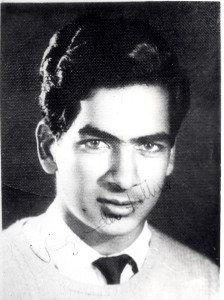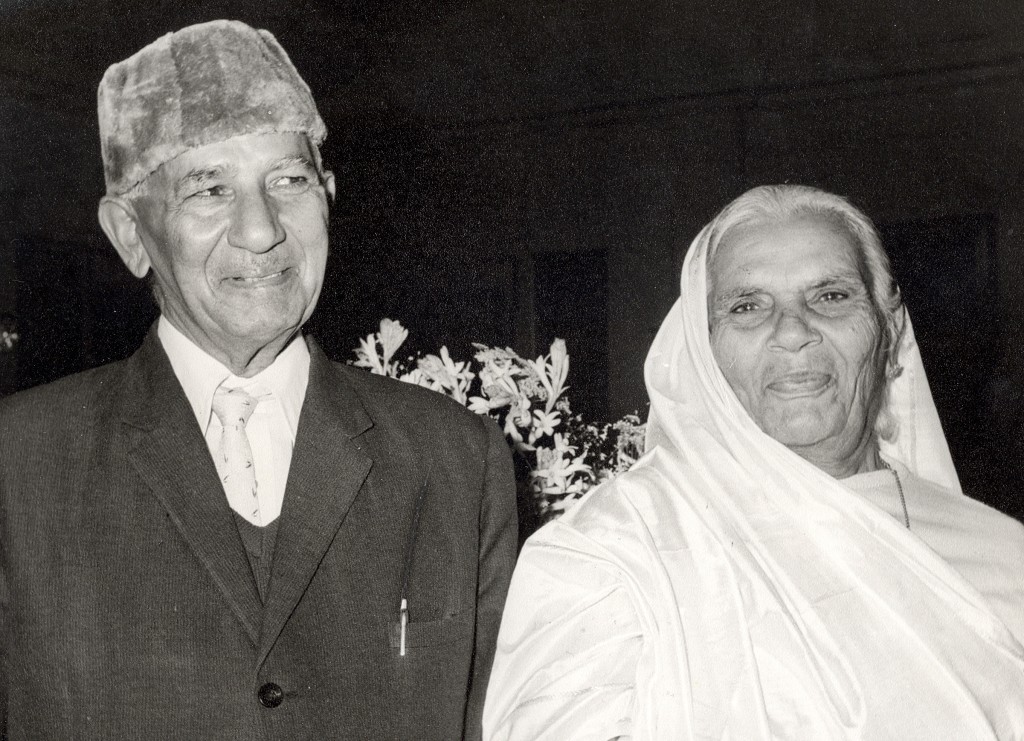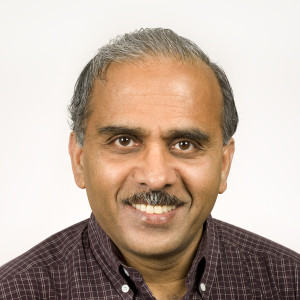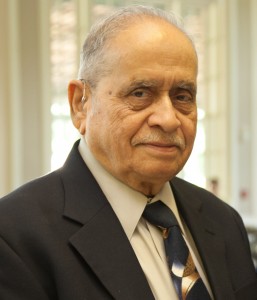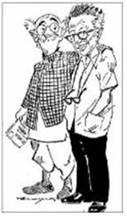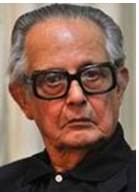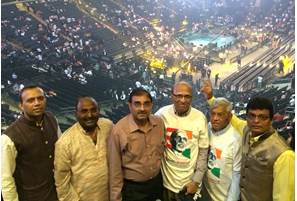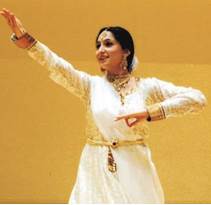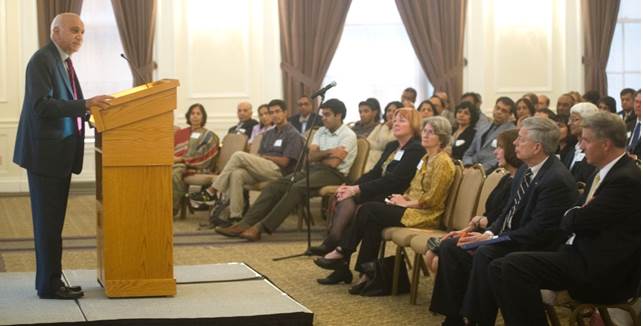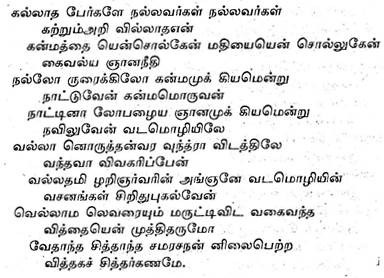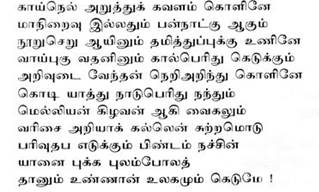Archive for category Past issues
Personally Speaking: Dreams Don’t Die
Posted by admin in April 2015 on April 12, 2015
By Juginder Luthra, Weirton, WV
e-mail:Â dolgin1968@gmail.com
Editor’s Note: Very often people realize their unfulfilled dreams — unfulfilled on account of the combination of several factors beyond their control — through the accomplishments of their children. No wonder in Sanskrit one expression for son is Atmaja, literally meaning “born out of oneself.†So, people see extensions of themselves in their children. Often, parents recount how they realized their dreams through their children. However, when a son recounts how he has been living his father’s dreams, the impact is very different. Here are Juginder Luthra’s recollections on his becoming a physician. He is close to retirement after practicing ophthalmology in Weirton, WV.
There was a flurry of activity all over the house. “Is the suitcase ready, did you pack enough mango pickle and praanthe with cooked dry potatoes placed between them? Are your shoes polished, do you have enough money for the journey? Do you have Dr. Chitkara’s (Pitaji’s cousin) address where you will be staying for the first 3 or 4 days?â€
The last one was planned to avoid the notorious, scary ritual of ragging, called hazing in the US, that every new student received from seniors.
“Make sure your shoes match; one black and one brown will look really funny. Don’t stick your head out of the moving train, you will get coal particles fly into your eye. Above all, no more mischief; you are a big boy now.â€
Questions and advice were coming from every corner and everybody. Mataji (as my siblings and I called our mother), with tears in her eyes and sniffling, said haltingly with a raspy voice, “Make sure you eat properly; I will not be there running after you with butter-soaked praanthe and your favorite bhindi and karele.†She kissed my forehead. Our tears mingled.
What was the fuss and occasion for all this hoopla in September, 1961 at house number 2, Model Town, Panipat, 50 miles north of New Delhi?
I was on my way out of the house at the age of 17, alone, and plunging into the large strange world. I grew up with the luxury of being sheltered by my mother, brothers, sisters, and Dadaji (paternal grandfather). And my father, who was mostly physically absent but in spirit always around.
After the Partition of India in 1947 and our arrival in India as refugees from what now had become Pakistan, the responsibility of supporting the large family was on Pitaji (Father). Money earned from the newly learned trade of making bricks was never enough. First, the eldest son, Suraj, followed next by Prem and then Virinder got jobs and supplemented his meager income. All of this combined money was barely enough to cover the basic needs of shelter and food. Mr. Kundan Lal Luthra, my father, recognized from his own personal experience that education was as essential as food. Educating his children was the main goal of his life.
Eleven boondi laddoos had been distributed as gifts to all the neighbors, appropriate donations had been made to the needy woman, Brahmni, who visited us weekly to receive money and food for her recently uprooted family. Ganesh, the Remover of Obstacles, had been invoked with indecipherable mantras. Proper blessings had been received from the family Gurus — Swami Satya Nandji and Shakuntla Behanji.
It, indeed, was a big occasion for the family and above all for Pitaji. I was the first child going to medical college, and hopefully becoming the first doctor in our family. The six older siblings had become engineers, businessman, and teachers. The one younger than me, the last one of the eight siblings, had declared his intentions of becoming an engineer.
I also had wanted to become an engineer — because I hated blood! In hindsight, what a foolish reason it was; but at that age, it was a major reason for me to join 2-year pre-engineering courses after high school. I had already attended pre-engineering classes for three months in 1959 at Government College, Rupar, Punjab.
A two weeks All India tour for me arranged through the college, gave Pitaji the window of opportunity to change the course of my life. In my absence, he went to the college, cancelled my physics and math classes and entered my name into botany and zoology. He also arranged evening tuition and extra classes to make up for lost time.
He was happy that I did not object and quietly followed the path carved out by him. I have been, forever, thankful for his foresight. We learned later that there was a whole different dimension to this action. It was a moment of fulfillment of a long, hibernating dream for Pitaji, the architect of education for the whole family.
Kundan Lal, my father, was one of two sons of Lala Gokul Chand. In the early 1900s Lalaji had been gifted ten acres of land in Khanewal (near Multan in Pakistan) by his British officer. Kundan’s younger brother, Karam Chand, was meant to take over the farming. Kundan loved to help people. What better way to serve than to become a doctor, was his thinking. With this goal in mind, Kundan studied pre-medical courses in Dayanand College, Lahore. He completed the prerequisite courses, and earned more marks than required to ensure admission in the prestigious Medical College, Lahore.
Much to Kundan’s disappointment, a Muslim boy with lesser marks, was given his spot due to the quota system then in practice. Not one to be defeated and give up, Kundan continued his studies, completing B.Sc. to definitely ensure admission to the medical college in the following year. His decisions and academic performance were on track.
But no one can foresee or predict the Hand of Destiny. What is not meant to be will not be, despite all our effort. You can come up with all descriptors — defeatism, a rational defense mechanism of acceptance, ingrained deep faith in Destiny, or Will of God as has been the Hindu way of looking at life’s transitions.
Those days, infectious diseases were common causes of death in all age groups. Kundan’s younger brother, Karam, fell victim to one such disease and died as a result. Their mother died shortly thereafter. Lalaji, Kundan’s dad, summoned Kundan back from Lahore to Khanewal to look after the land. His pleas to let him continue the education fell on deaf ears. One could cry and make a scene, but in those days one dare not refuse the dictates of the family elders. Such was the culture of that era (circa 1925).
Kundan Lal, the budding doctor, overnight became doctor of the crops. And what a farmer he became! Farmers from all around Khanewal sought his advice on all aspects of farming.
However, the suppressed, dormant and hibernating seed of becoming a doctor never died in him. One day it had to sprout.
He must have seen something in me akin to himself and saw a doctor in me serving humanity.
That is how my pre-engineering studies became pre-medical. After getting sufficient grades, I got selected into Medical College, Amritsar, nearly 250 miles from Panipat and only 20 miles away from Lahore, Pakistan.
I was finally ready to embark on the daunting, lonely journey to Amritsar on a newly started train, the Flying Express. After the flurry of activity at home, good byes, tight hugs and tears, Pitaji escorted me to the train station. The train, as usual, was running late.
He would not talk much, but looked at me with his usual style of tilted head with a slanted gaze, a tear building up in the corner of his eyes. He carefully wiped it by the same motion as if he was straightening his hair, hoping the train would be a little more delayed.
A loud whistle, a down green signal, and the plume of smoke from the steam engine fueled by coal far away, broke Pitaji’s trance. Overhead speakers announced the arrival of the train that would take his son away to finally fulfill Kundan Lal’s long cherished dream. The tears he held back could not be subdued any longer; a mixture of joy and sorrow moistened my cheeks and collar as he gave me a tight reassuring hug.
The train rolled out gently. His blessings to serve people, and become as good a doctor as he had dreamt to be, kept following me through his loving gaze, gradually fading smile and waving of his hands. Â Â Â Â The End
Dekho Hamara Amreeki Desh !
Posted by admin in April 2015 on April 12, 2015
By K S Venkataraman
e-mail:Â ThePatrika@aol.comÂ
We’ve occasionally published stories under Dekho Hamara Hindustan highlighting how uninformed some of the Indian elected officials can be. The rights of elected officials to publicly display how dumb they are have no geographic boundaries. Here is an Amreeki version.
In February 2015, the Idaho legislature held a hearing on a bill that proposed to ban doctors from prescribing abortion-inducing medications through telemedicine. Idaho’s state representative Rep. Vito Barbieri (GOP) (see the picture) was in the committee hearing of people both supporting and opposing the bill.
Dr. Julie Madsen, a physician who provides various telemedicine services in Idaho, was opposing the bill that will restrict doctors from prescribing medications to terminate pregnancies such as the “Morning-After Pill.â€
The legislators were asking Dr. Madsen about colonoscopy to see if it could be done noninvasively. Here are the exchanges in the hearing:
 Rep: Barbieri: You mentioned the risk of colonoscopy. Can that be done by drugs?
  Dr. Madsen: Mr. Chairman, Rep. Barbieri, it cannot be done by drugs. It can, however, be done remotely, where you swallow a pill, and this pill has a little camera, and it makes its way through your intestines, and those images are uploaded to a doctor who’s often thousands of miles away, who then interprets that.
  Rep. Barbieri: Follow up, Mr. Chairman.
  Chair:  Rep. Barbieri.
  Rep. Barbieri: Can this same procedure then be done in a pregnancy? Swallowing a camera and helping the doctor determine what the situation is, with the … …
  Dr. Madsen:  Mr. Chairman and Representative, it cannot be done in pregnancy simply because when you swallow a pill, it would not end up in the vagina.
[laughter]
  Rep. Barbieri: Fascinating! That certainly makes sense, doctor.
The laughter in the room at Dr. Madson’s response to Rep Barbieri’s question was not a polite one. It was derisive because of the Republican state representative’s ignorance on the basic anatomy of the human body.    —   The End
…   — By K S Venkataraman
Excellence in Teaching and Research — Prof. Vijayakumar Bhagavatula
Posted by admin in April 2015 on April 12, 2015
By Prof. Pandu R. Tadikamalla
Katz School of Business, University of Pittsburgh, PA 15260
e-mail:Â Â pandu@katz.pitt.edu
Note:  Pandu Tadikamalla is a professor of Business Analytics and Operations at the Katz School of Business. He came to the US in 1970 and earned his MS and PhD from The Univerisity of Iowa. He lives with his wife Rama in Squirrell Hill.
Professor Vijaya Kumar (popularly known as Professor Kumar to his students and peers) received the U.A. and Helen Whitaker professorship of Electrical and Computer Engineering at the Carnegie Mellon University on November 25, 2014.
The professorship, established in 1973 by U.A. Whitaker (E’29) and Helen Whitaker, recognizes a faculty member for important, cutting-edge research in Electrical and Computer Engineering.
After receiving his PhD in electrical engineering from Carnegie Mellon in 1980, Vijaya Kumar joined the faculty at the university in 1982. His B.Tech (1977) and M. Tech (1980) were in electrical engineering from IIT Kanpur, India. He is currently the associate dean for Graduate and Faculty Affairs for the College of Engineering. He has also served as interim dean for the college and as acting department head of Electrical and Computer Engineering.
Prof. Kumar, an excellent teacher and researcher, leads many important studies at Carnegie Mellon. He has carried out important work in matching live biometric signatures with stored templates through correlation. Kumar and his students are also developing several spatial frequency-domain methods to perform these correlations in the presence of significant appearance variability such as illumination changes, expression differences, and others in the biometric signatures. These correlation filters have performed well in competitions such as the Face Recognition Grand Challenge (FRGC) and Iris Challenge Evaluation (ICE) conducted by the U.S. National Institute of Standards and Technology (NIST).
Dr. Kumar has published nearly 200 research papers in journals; and has written eight text books and supervised over fifty PhD students. Countless number of students have earned their master’s degree under him. He is also a Fellow in four professional societies related to his field.
In the investiture ceremony for the chaired professorship, Dean James Garrett of the CMU College of Engineering, Dr. Abjiji Mahalanobis, a senior Fellow at Lockheed Martin, and Dr. Pradeep Khosla, (former dean of the CMU College of engineering and currently the Chancellor of University of California, San Diego) also spoke. One common theme in their speeches was Kumar’s passion for teaching and research. In addition to his scholarship, he is also known for his collegiality and willingness to help his colleagues and students at all times without any reservation.
Vijaya Kumar comes from a family of accomplished professionals. His three sons are all engineers, graduated from Carnegie Mellon with masters and PhD degrees. His wife Latha is the operations manager at the S.V. Temple in Penn Hills. Latha has coordinated several Telugu cultural activities including teaching Telugu at the S.V. Temple.
Despite all his accomplishments and professional recognition he has received, Dr. Kumar is very modest about his track record.
Please join me in congratulating Prof. Vijaya Kumar for his academic excellence and dedication to research and teaching. Â Â The End
Continuing Care at Home (CCAH) Programs: An alternative to Long Term Care insurance
Posted by admin in April 2015 on April 12, 2015
Balwant N. Dixit, Ph. D.
Professor of Pharmacology (Emeritus)
608 Ravencrest Road, Pittsburgh, PAÂ 15215 USA
Phone: Â (412) 963-8023 Â Â Â Â e-mail:Â Â bdixit@pitt.edu
In the January 2015 issue of Pittsburgh Patrika I wrote about an unexpected medical emergency my wife, Vidya faced during our short visit to Washington DC. After her return to Pittsburgh by ambulance, Longwood at Home (LaH), a Continuing Care at Home (CCAH) Program, provided Vidya excellent help when it was most needed. LaH is located in the Pittsburgh area providing services to members that reside in the five county areas in Western Pennsylvania (i.e. Allegheny, Beaver, Butler, Washington and Westmoreland). Vidya and I became members of LaH three years ago and have been very satisfied with the services its staff has provided to us. I hope that readers of Pittsburgh Patrika will find the following information about CCAH programs useful.
Continuing Care at Home (CCAH) Programs and their Locations: CCAH programs, a unique alternative to Long Term Care Insurance (LTCI) are not very common but are expected to expand in the future as “baby boomers†retire. This mode of service delivery is ideal for the middle-income seniors who choose not to move into one of the traditional Continuing Care Retirement Communities (CCRC) which are usually quite costly, still receiving the full continuum of care similar to a CCRC. At present, CCAH programs are available in six states; New Jersey, Pennsylvania, Ohio, Tennessee, Maryland and Delaware. Most offer portability within the USA after being a member for a year or more. A CCAH program in California (CA) is in its final stages of legislative approval. Details about LaH and Friends Life Care (FLC), a CCAH program located near Philadelphia, PA, provides similar services to the residents of Eastern Pennsylvania and Delaware (DE).
(1) Longwood at Home: LaH (http://www.longwoodathome.org), is licensed by the Pennsylvania Department of Insurance and is a unique alternative to Long Term Care insurance (LTCI). LaH is affiliated with Presbyterian SeniorCare, an accredited Aging Services Network (http://www.srcare.org/).
The following are important features of Longwood at Home: (i) Service & Care Options: One-time enrollment fee and low monthly fee provides a member access to a continuum of services right in your home. A portion of the fees (usually around 85%) is Federal Tax deductible since it is attributable toward medical expenses. LaH membership guarantees the very best private duty and facility- based care as your needs change. (ii) Care Coordination & Care Continuum: As a member of LaH, a personal Care Coordinator is assigned to you, and can arrange any service you might require. In the event of an emergency, Care Coordination staff is available 24 hours a day, seven days a week. As your needs change, LaH can coordinate a variety of care options from companion/homemaker services, to licensed home healthcare and home care aide services and live-in assistance. (iii) Home Inspection: During the first year of membership and every other year thereafter, LaH provides a licensed therapist to do a safety and functional inspection of your home and make modification recommendations. (iv) Transportation: LaH provides transportation both ways for medically necessary outpatient procedures and for hospitalizations. A care giver always accompanies a member during such appointments. LaH can also assist with transportation coordination for other needs, such as routine doctor visits, however members are responsible for the costs for such visits. (v) Coverage Options: LaH offers six levels of coverage for healthy adults age 60 and over. Each offers the opportunity to remain independent in one’s home, services of a professional Care Coordinator, with access to a lifetime of excellent, affordable care and services as your needs change. (vi) Insurance: Members are required to maintain Medicare A & B insurance plus Medicare Supplemental Insurance (a Medigap plan) or a Medicare Advantage Plan, both being offered by private insurance carriers. (vii) Residential requirements: One must be a resident of the five county area of Western Pennsylvania on the day he or she decides to enroll. (viii) Portability: Arrangements can be made for providing similar services at no extra cost, for a member who has completed at least one year with LaH, while travelling or residing outside the service area of the five counties, but within the USA, (ix) LaH Membership for those who have Long Term Care Insurance (LTCI): A person with LTCI can become a member of LaH. If the policy holder meets the criteria for LTCI coverage (i.e. inability to perform two activities of daily living for 90 days or severe cognitive impairment) his LTCI policy can be used to pay the monthly premium for LaH. LaH does what the LTCI carrier will not do, in that LaH offers personal care coordination and immediate response – any change in health or functional status or inability to perform one activity of daily living – no waiting period. However, if one stops paying premiums for LTCI, coverage will cease.
(2) Friends Life Care (FLC): Founded in 1985, FLC is a nonprofit Quaker organization serving eastern Pennsylvania and Delaware ((http://friendslifecare.site-ym.com). FLC is regulated by the Pennsylvania Department of Insurance as a Continuing Care Retirement Community (CCRC), and like LaH provides professional care management, home care and related personal care services. Headquartered near Philadelphia, PA, FLC operates in eastern Pennsylvania and Delaware. Residents of both states qualify for membership. The plan is portable for members who relocate within the PA or DE or the USA—either to another state or region, or into another living arrangement, including downsizing to an apartment or a fee-for-service retirement community. For members who relocate, and for those who like to travel, FLC arranges care through affiliated organizations that meet their rigid standards of excellence. FLC extends membership to adults aged 40 to 81 who are in reasonably good health and living independently but not currently in a facility.
Acknowledgment: Advice given by Grace Smith of LaH, Sudhir Manohar and Girish Godbole is gratefully acknowledged. Â Â End
“Asianization†of America is Real!
Posted by admin in April 2015 on April 12, 2015
By Kollengode S Venkataraman
e-mail: Â ThePatrika@aol.com
 Sometime back, I wrote an article titled Asianization of America that my reviewer did not like on the first go. After a long discussion, she grudgingly said, “OK, may be you can run this.â€
My point was that in the US too, much like in Asia (India, China), graduates in humanities, social sciences, literature, and performing arts are getting fewer well-paying jobs offering health insurance. So, everybody was chasing degrees in engineering, business, finance…
And then came this article by Gary Gutting, a professor of philosophy at the University of Notre Dame, and editor of Notre Dame Philosophical Reviews, titled “The Real Humanities Crisis†in the New York Times of Dec 1, 2013. See here: www.tinyurl.com/humanitiescrisis. These excerpts tell the crisis in the US is identical to what has been happening in India for the last 50 years:
“Humanities majors on average start earning $31,000 per year and move to an average of $50,000 in their middle years. (The figures for writers and performing artists are much lower.) By contrast, business majors start with salaries 26% higher than humanities majors and move to salaries 51% higher.
“… … Even highly gifted and relatively successful writers, artists and musicians generally are not able earn a living from their talents. The very few who become superstars are very well rewarded. But almost all the others — poets, novelists, actors, singers, artists — must either have a partner whose income supports them or a ‘day job’ to pay the bills. Even writers who are regularly published by major houses or win major prizes cannot always live on their earnings.â€
This has been the experience of Indian performing artists and writers both here and in India for over 60 years. Â In India – Â and for that matter, even in the US — Â how many of the Indian vocalists, dancers, and instrumentalists and writers can sustain their middle-class life style if they are going to depend only on the earnings through their skills as artistes and writers? Almost NONE. Â Most of them have full-time jobs or have professional spouses to give them the middle-class life style. Â This is a simple fact.
Prof. Gutting continues:
“With tenured professorship at a university, or if you play regularly in a major symphony orchestra or write mega best sellers, you can earn an excellent living doing what you love. Short of that, you must pursue your passion on the side.” This is what many well-known Indian writers have been doing for the last several decades.
Gutting Continues: “Teaching should be an obvious solution for many humanities majors. But well-paying tenure-track jobs are disappearing… half of college teachers now are part-time adjuncts… who fail to make a living wage. ”
This only confirms that as a consequence of globalization many social problems of the industrialized West increasingly resemble those in India, China, Taiwan.    The End.
Rare Candor in Diplomatese
Posted by admin in April 2015 on April 12, 2015
By Kollengode S Venkataraman
In diplomatic exchanges, it is all about nuances, parsings, minutiae, contextualizing, saying something and meaning/implying something very different, and conveying decisions by silence and pauses, or not stating anything at all on specific topics. But the following two examples are in stark contrast making candor a virtue, even when dripping in sarcasm:
Greece, a member of the EU, is close to economic collapse in the wake of long economic mismanagement of the country — rampant tax evasion, crony capitalism, nepotism, nexus between politicians and businesses… After the recent elections in Greece, the new leftist government’s finance minister met with Germany’s financial officials for help. Germany is the EU’s economic behemoth demanding fiscal discipline among the EU’s members. The early meetings between the two went nowhere.
In meeting reporters, Germany’s staid finance minister was trying to be diplomatic and told reporters, “We agreed to disagree.†The Greek finance minister standing by quickly offered this impolite retort: “We didn’t agree to disagree. We agreed to enter into a discussion for a joint solution for all European partners.†You figure this out.
After the Russian army entered into Crimea, a region populated by ethnic Russians in Ukraine, in early 2014, the West imposed sanctions on Russian businessmen and blacklisted many Russian businesses close to Putin. The affected Russians mocked the sanctions, wearing them as a badge of honor.
These sanctions also rankled Moscow’s politicians. Russia’s deputy Foreign Minister Sergei Ryabkov told this gem to the Interfax news agency regarding the Russian military actions in Crimea:
“What can one advise our U.S. colleagues to do? [Go and] spend more time in the open, practice yoga… …[and] maybe watch some comedy sketch shows on TV. This would be better than winding oneself up and winding up others, … The ship has already sailed … Tantrums, weeping and hysteria won’t help.â€
This quote will enter into the annals of famous quotes in international relations. Â End
Rita Ganguly’s Enchanting House Concert
Posted by admin in April 2015 on April 12, 2015
By Seema Chaubey, Irwin, PA
e-mail: Â seemachaubey@hotmail.com
Note: Seema Chaubey is from Kolkata, India She learned Hindustani music from Ashim Mitra and the late Sachin Das Motilal in Kolkata. She is a music lover and resides in Irwin, PA with her family.
On November 15, 2014, Chhandayan, the Pittsburgh-based organization dedicated to Hindustani music, presented their third and last house concert of 2014 at Samar and Mala Saha’s home in Irwin, PA with nearly fifty people in the audience. The star of the evening was the notable vocalist Padma Sri Rita Ganguly (Rita-di for her admirers), accompanied by Pandit Samir Chatterji on the tabla and the young and talented Amir Khan on the sarangi. Pittsburgh’s Ayan Sinha provided harmonium support and Ganguly’s daughter Meghna Kothari was on the tanpura and provided vocal support. The picture below shows the ensemble of the artistes.
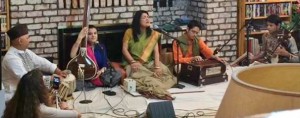 Before Rita took the stage, the musical program began with Amie Maciszewski’s short and sweet sitar recital. She is from Dallas, Texas and was trained by sitarist Suresh Misra and Grammy winner Ustad Asish Khan. She began with raga Puriya Dhaneshwari, a twilight melody and unfolded the raga in the traditional manner of three movements – a leisurely Alap, followed by the slow Vilambit Gat, ending in a climax in Drut Gat. She ended her recital with a shorter piece in Misra Todi. Pittsburgh’s Asish Sinha provided percussion support on the tabla, ably responding to the sitarist’s Drut Laya Bols with his Paltas.
Before Rita took the stage, the musical program began with Amie Maciszewski’s short and sweet sitar recital. She is from Dallas, Texas and was trained by sitarist Suresh Misra and Grammy winner Ustad Asish Khan. She began with raga Puriya Dhaneshwari, a twilight melody and unfolded the raga in the traditional manner of three movements – a leisurely Alap, followed by the slow Vilambit Gat, ending in a climax in Drut Gat. She ended her recital with a shorter piece in Misra Todi. Pittsburgh’s Asish Sinha provided percussion support on the tabla, ably responding to the sitarist’s Drut Laya Bols with his Paltas.
Ganguly took the stage starting with Mere Shyam Na Aye, a bol Banao Alap in Raga Jhinjhinoti and Jat Tal, a short piece on the yearning of one’s soul for the spiritual love of Shyam. Her next number Hamri Atariyape Aayo Sanwaraia was a traditional Thumri in Sindhu Bhairav, a musical composition of her guru Begum Akhtar using Gulzar’s lyrics. Ganguly’s deep, husky and richly-timbered voice and the momentary split in her voice, called “Patti,†reminded the older members of the audience of Begum Akhtar.
Her next piece Koyelia Mat Kar Pukar, a familiar Dadra, immortalized by Begum Akhtar, made the audience hum and sway to the melody. Next was Mere Humnafas Mere Humnawa, a Shakel Badayuni’s ghazal in raga Darbari, which translates to “It may or may not work, but you do not refrain from beseeching the object of your love, who has showed signs of wavering, not to betray you.â€Â Ghazals bring out the finer nuances of true love, and the Sufi system of seeing the Creator as one’s lover elevates the romance in the song to a higher level. Although many of us were not well-acquainted with Urdu, the performer’s explanation and the mesmerizing rendition took us to that higher plane.
Rita next moved into a new genre of her own called Jibanmukhi, similar to the Urdu Nazm. She presented three poems of Bengali poets Shakti Chattopadhyaya and Shankha Ghosh and interpreting them with music in the tradition of the Nazm.
Rita continued with a couple more ghazals before concluding her recital with the ever-familiar and much-requested Aye Mohabbat Tere Anjaam Pe Rona Aya, a Shakeel Badayuni’s Ghazal in Bhairavi.
All through Ganguly’s recital, Samir-ji’s tabla was telling a story of its own, on how tabla can open up the flood gate of emotions hidden in Hindustani semi-classical compositions.
The young and very talented Amir Khan’s accompaniment on sarangi was haunting and melodious, keeping in tune with the songs of Rita Ganguly.
Samar Saha, the host, welcomed the artists and offered the concluding remarks before serving a delicious buffet-style dinner. Â End
Summerset at Frick Park: Ideal for Families
Posted by admin in April 2015 on April 12, 2015
By Melissa Reich
Home Sales Expert, Summerset at Frick Park
1435 Parkview Boulevard, Pittsburgh, PA 15217
Phone: Â (412) 215-8056
 Many Indian families choose Summerset at Frick Park because of its proximity to cultural and religious attractions, as well as its convenience to the Waterfront, downtown, and Oakland. A short drive from many places of worship for Indian-Americans in Monroeville, residents have a religious community nearby. Additionally, the neighborhood is close to many Indian grocery stores and restaurants in Monroeville and Oakland as well as the Strip District markets.
Many Indian families choose Summerset at Frick Park because of its proximity to cultural and religious attractions, as well as its convenience to the Waterfront, downtown, and Oakland. A short drive from many places of worship for Indian-Americans in Monroeville, residents have a religious community nearby. Additionally, the neighborhood is close to many Indian grocery stores and restaurants in Monroeville and Oakland as well as the Strip District markets.
The convenience of city living paired with the neighborhood’s park-like atmosphere and access to Frick Park attract many diverse groups to the neighborhood. International residents move there because of its location near Pittsburgh’s medical, technology, and entertainment hubs. However, it is also home to many longtime Pittsburghers moving back into the city who are interested in customizing a new home.
Summerset at Frick Park families can ensure an excellent education for their children through access to the best private and public schools in Pittsburgh. Within walking distance of award-winning Allderdice High School, teens also have the option of attending the Pittsburgh Creative and Performing Arts School (CAPA), or one of the many private high schools nearby. Allderdice was ranked #9 in top SAT scores for 2014 in the Pittsburgh region, with CAPA just behind it at #10. Ellis and Shady Side Academy boast a diverse student body, small class sizes, and committed, experienced teachers. Music teachers living in Summerset at Frick Park, as well as nearby gifted afterschool programs at Pittsburgh’s universities, allow unique opportunities for enriching children’s education.
For higher education and medical needs, various universities and medical centers are nearby. The University of Pittsburgh, Carnegie Mellon University, Duquesne University, Point Park University, Carlow College, and Chatham University are all within 15 minutes of Summerset at Frick Park, so the community’s professors, medical professionals, and business leaders all enjoy a quick commute to work every day.
With a variety of new home construction options, Summerset at Frick Park has something for everyone. Facing east and south, the Schneider Park and Parkview townhomes range from 2,110 to 2,860 square feet, featuring open first floor plans that allow residents to create their own layout.
In addition to beautiful river views, townhomes include three bedrooms, covered front porches, attached garages, private outdoor spaces, and professional landscaping. End units offer a first floor master suite along with a third floor bonus loft and flexspace that are customizable to meet residents’ needs and perfect for extended family and guests. Buyers also have the option of adding an in-law suite, office, or gym.
In addition to its townhomes, Summerset at Frick Park also offers one-level condos called Manor Flats. Manor Flats offer 2,000 square feet of space with two bedrooms, a study, spacious walkup front porches, and covered side terraces. Also included are two parking spaces in the garage, an elevator, low maintenance exteriors, and professional landscaping.
Townhomes and manor flats are selling quickly, so please set up an appointment today by visiting www.SummersetatFrickPark.com or by calling home sales expert Melissa Reich at (412) 2158056. Â End
R. K. Laxman, the Irreverent Cartoonist
Posted by admin in April 2015 on February 1, 2015
By Kollengode S Venkataraman
e-mail: Â ThePatrika@aol.com
Recently, Rasipuram Krishnaswamy Laxman, the most celebrated cartoonist of India and the father of the dhoti-clad Common Man (archaic in today’s Indian metros) died at 94 in Pune after a well-deserving, well-earned, illustrious career spanning several decades.
Decades ago, Bombaywallahs — now Mumbaikars — and people in many other cities started their day only after reading Laxman’s “You Said It†cartoons in the Times of India. No one – whether politicians, the babus (bureaucrats), the poor, the rich, or the vainglorious  — escaped Laxman’s skewering, yet humorous wit focusing on human foibles, hypocrisy and inner contradictions.
He was keenly observant, very much in touch with the pulse of urban Indians, a common trait among social commentators whether columnists or cartoonists. His obituary ran in the English media worldwide. Tributes in India were torrential.
He was cremated in a private ceremony in Pune. The Maharashtra government gave him a ceremonial state funeral, a great honor for a cartoonist.
Lavishly praising the dead while overlooking their imperfections is an Asian trait. There is a popular and cynical saying in Tamil, settavan kannu sentaamarai, which translates in Hindi as murdaa kaa aankh gulaabi-kamal. In English, this would mean “The dead have golden eyes.† There is no popular English equivalent expression though, probably because there is no inhibition in critiquing the dead.
After Laxman’s death, his son Srinivas, a journalist with the Times of India, talked to his colleagues reminiscing his dad. One point he said is worthy of our attention (www.tinyurl.com/Laxman-Srinivas):
Srinivas said that the legendary cartoonist never conformed to rituals. “My father was accorded a simple funeral, without the rituals he himself never followed. I still remember my father’s reaction when he heard the news of his mother passing away . He had this habit of sitting with a drink at 9pm and listening to the radio. One day, he received a phone call from his brother informing him of his mother’s demise. She had passed away in Mysore. My father was immensely shaken with the news, but did not go to Mysore. He was very progressive; he did not observe rituals and was not a traditionalist,†said Srinivas.
Obviously, the other siblings of Laxman in Mysore who took care of his mother in her last days — a far more difficult responsibility if she was bed-ridden in her old age — also took care of her cremation.
Death rites are quite simple compared to providing hospice care for old people till they pass on. In India, even today, the options for hospice care are few even for its professional middle class, not to speak of India’s working poor. People taking care of old sick parents know this.
If Laxman had personal reasons for not going to his mother’s funeral, we need to respect and honor his private decision, and it would have been graceful for Srinivas to leave this biographical detail of his father private. But Srinivas went public on this, trying to correlate Laxman’s persona as a non-traditionalist and non-believer in rituals with he not going to his mother’s funeral rituals. This was unnecessary to say the least.
What has R. K. Laxman’s non-belief in rituals and traditions anything to do with Laxman not going to his mother’s funeral in Mysore? Honestly, is there any correlation between one’s non-belief in rituals and one not going to the funeral of one’s parents?
Laxman, decades ago, did not believe in the old rituals for his mother’s last rites. Such a radical departure from tradition decades ago would have jibed well if Laxman, given his star image, had instructed his son not to follow contemporary death rituals like public viewing, wreath-laying, etc. And the non-traditionalist Laxman’s son conformed to the “modern†traditions and rituals associated with a state funeral even as he was disdainful of “old†rituals.
Ever since Homo Sapiens started living in social groups for collective security, mankind in different parts of the world independently evolved norms and conventions for its members to follow to make human interactions predictable and meaningful. Death rituals, whether contemporary or old, are part of these norms for people to gather to mourn and reminisce the departed.
These norms, necessary for enabling all kinds of transactions needed among people, are contextual with respect to time, place, culture and other factors. And they have been evolving through the millennia.
And today’s “progressive†ways of taking care of the dead are tomorrow’s dogmas, traditions and empty rituals. After all, all rituals are always in transition all the time.    ♦
Cultural Continuum — the Cause of Conflicts
Posted by admin in January 2015 on January 21, 2015
By Kollengode S Venkataraman
e-mail: ThePatrika@aol.com
After World War I and the collapse of the Ottoman Empire in the 1910s and later decades, victorious France and England recklessly sliced and diced the Middle East, Africa and the Indian subcontinent to serve their interests, unconcerned about the regions’ histories and traditions. Remember, these large areas — Egypt, Iraq, Syria, Turkey, Iran, and the Indian subcontinent — are standing on a cultural and civilizational continuum going back at least 5000 to 6000 years. After WW I, the US joined the Big Boys, eventually becoming the Biggest Boy. The problems festering in these regions today can be traced back to this recklessness.
The West may gloss over what they did to these people as de facto rulers’ even putting a positive spin on the goodies they brought to the regions. But people in the areas have a very different collective memory of their histories. And these people, as people everywhere, live in a cultural continuum identifying with their long histories. This should surprise no one. Consider these:
The Chicago Cubs have not won the World Series in over 100 years. If the Cubs won today, their fans would go berserk. We would understand this as perfectly normal, and even rejoice in their victory. But in those 100 years the owners of the Cubs have changed, and so also their logo, uniforms, fan base and players. Only the Roman letters CUBS and their vocalization have remained constant. Yet, Chicagoans and baseball buffs see continuity through these 100 years of changes and passionately identify themselves with the Cubs’ successes and failures. Whole cultures — not to speak of profitable businesses — are built around such illusional identities.
Jews scattered all over the world today feel that on the basis of their scriptures and their version of history, they have claims on the land in the Palestine their ancestors left four millennia ago. See here: http://www.jewishvirtuallibrary.org/jsource/Judaism/biblejew.html. Remember, each millennia is roughly 40 generations. In the last 100-plus years, Western powers and global power brokers have supported Jews’ claims, a privilege given to no other ethnic group in the world.
Ethnic groups in the former Yugoslavia –the Bosnians, Croats, Serbs, Macedonians, and Slovenians –– recall the internecine wars that ravaged on their lands several centuries ago as if they occurred only yesterday and display their ethnic hatred to each other even now.
In Islam, during Muharram, Shias all over the world passionately remember and lament the murder of Hussein Ali, the grandson of the Prophet Mohammed over 1400 years (50 generations) ago by opponents on the contentious issue of who should succeed the Prophet.
And of course, Christendom has its Good Friday on which the faithful somberly remember the crucifixion of Jesus of Nazareth, the Son of their God, over 2000 years ago. The followers of Jesus at that time collectively accused all Jews living there of the crucifixion of Jesus, himself a Jew. This was one reason for the anti-Semitism and the persecution of Jews in Christian Europe. Only after almost 2000 years, during the Second Vatican Council (1962–1965), the Catholic Church under Pope Paul VI repudiated the belief in the collective Jewish guilt for Jesus’ crucifixion.
Similar stories in India are too many given its long history and social complexities with subtexts based on differences in languages, religions, sects, and social stratification and compartmentalization. It is worth recalling the words of Wali Khan, the Pashtun leader of Pakistan and the grandson of the Frontier Gandhi Khan Abdul Ghaffar Khan: “I’ve been a Pashtun for 4000 years, a Muslim for 1400 years, and a Pakistani for 40 years.â€
Group identity has many virtues, even as it gives exclusiveness, vanity or victimhood to its members. One feature common to all types of group identities is that people belonging to any one group look at everybody else as “the Other.â€Â When these identities are branded on large ethnic groups, it leads to dislike, aversion, hostility; and when tolerated by the ruling system, to discrimination, persecution, and xenophobia.
Let us see how it operates in the Indian subcontinent: No matter what they teach in the sanitized school history books in India, its history subjectively internalized by India’s Hindus and Muslims is so divergent. Pakistan’s history books are not even sanitized. By their own account, they are full of distortions and lies, and anti-India and anti-Hindu. Read the multi-part essay What is the most blatant lie taught through Pakistan textbooks? in Dawn (http://www.dawn.com/news/1125484), and the 300-plus comments at the end of the article. On YouTube several video clips by veterans in Pakistan are available on this very subject.
One reason for the communal tensions in India is Indian intellectuals’ inability to come up with an unvarnished and matter-of-fact narrative of its pre-Mughal, Mughal, and post-Mughal history — warts and all — without glossing over the unpleasant elements that are part of all histories. Without such a common narrative, mutual distrust runs just below the surface among Hindus and Muslims. Even a small trigger — such as miscreants throwing a piece of beef into a temple, or driving a pig into a mosque is enough to ignite a communal conflagration.
In this context, the US, compared to England, France, Spain, and Portugal, has done a far better job in coming to terms with its racial history. That is why the US has moved forward on racial matters — always a work in progress — far ahead of the European colonizers of Africa. This is a good lesson for India to learn and implement in the Indian context.
Living in this continuum, people pass on their collective and skewed memories of pride, honor, victimization/humiliation, from one generation to the next. And our behavior is driven by the visceral and often prejudiced beliefs internalized from what we hear in family gatherings, social groups, and places of worship. Anthropologists call it meme.
Now, with social media to stay here and become even stronger, no one organization or group of organizations, however powerful they may be, can control the flow of information, or thinking and behavior of peoples.
In this environment, groups of ethnically, religiously, linguistically, and/or racially distinct people traversing in their own orbits, out of necessity, as they have been all along, overlap and intersect with others’ orbits. So, how can the interactions among these groups be made such that they are respectful of each other and can live in relative peace?
Can political and religious leaders help us? With very few exceptions, the track record of political and religious leaders over the last 2500 years is not reassuring. Religious leaders, steeped in their own dogma, are unable or unwilling to unlearn the arbitrary axioms on which they have built their edifices. These axioms are in mutual conflict with each other, and are, to begin with, the root cause for many conflicts. Political leaders have their own compulsions, particularly in a democracy.
Can today’s social thinkers address the problem? Given the lack of mass appeal of cerebral minds in general, this is not likely to happen.
What is likely to happen? Conflicting ideas have always existed, and will always exist, and so are the urges by nation-states to annex strategic land masses and waterways. Resolving these conflicting ideas and pursuits will not be always peaceful. The League of Nations and the UN in the last 100 years could not prevent WW-II, the Korean and Vietnam wars, the on-going wars in Afghanistan, Iran, Iraq, and in the larger Middle East.
Most likely, the world will move episodically from one convulsion to the next, some really big, many small. All we can do is to learn to manage the conflicts without too much bloodshed, and lengthen the gap between the episodes. This conclusion is more realistic, though not reassuring. We cannot hope for more. If we can accomplish this, that in itself is a great achievement. ∎ — END
Superstar Welcome to Prime Minister Narendra Modi
Posted by admin in January 2015 on January 21, 2015
By Vinod Doshi, Monroeville, PA
e-mail:Â doshivi@gmail.com
And why not? After 67 years of dynastic rule, economic decline and rampant political corruption in India, the Indian-American Diaspora was eagerly waiting to hear Prime Minister Narendra Modi, elected with an absolute majority in the May elections for the first time for any non-Congress government in India. The venue was Madison Square Garden in New York with a seating capacity of 20,000 people.
And what a superstar welcome it was! The head of the government of the world’s largest democracy was visiting the world’s most powerful democracy. No other foreign political leader in US history has received such a tumultuous welcome addressing a large and diverse audience (in the Indian context) of 18,000 people gathered in one place. History was made. It was an experience never to be forgotten.
The event was conceived and managed by the Indian American Community Foundation with 400 US-based organizations as members. Actually 700 organizations had applied but only 400 were approved.
Our Pittsburgh Organization was called “Sevapgh.orgâ€, with our group leaders Mr. Harilal Patel and Mr. Hitesh Mehta. Each organization was issued tickets depending on the interest shown. 110 people had registered from Pittsburgh but we were allotted only 83 tickets. As a result, some people who had applied late could not be accommodated. Forty-eight of us went in a bus. Others made their own transportation arrangements. We had to give full background information for security verification by the local organizer. Several thousand tickets were given out for free on a lottery basis. There were 10 applicants for each ticket given out in the lottery. People who did not get a ticket — there were several thousands of them — saw the event live outside MSG or on the large screens at the Times Square. Furthermore, the event was also beamed live to forty university campuses nationwide.
The well-managed program was organized with financial support from various social, religious, political, educational, and cultural organizations and temples of all denominations throughout the country; and from individual community, political and industry leaders.
At the end of the fun-filled bus trip (arranged by Chetan Patel), we were dropped a couple of blocks from Madison Square Garden. People were converging on the venue from all directions. Lines were very long, but orderly. Security was very tight. What was allowed inside and what was not was clearly conveyed to us in advance — no cameras and no note books. Smart-phone cameras were OK. At the entrance, they were checking our tickets against our photo IDs. The whole atmosphere was exciting with a lot of buzz. People were eager to see and hear India’s new prime minister. We received a white MODI T-shirt as a souvenir.
The Indian Diaspora at the Garden represented a wide cross section, and was reassuringly diverse in the Indian context. One could see a large number — roughly 1/3 of the crowd — of women of all ages. Youngsters too were there, many of whom were born and raised here.
Nearly 40 high-profile Congressmen and U.S. senators were there to hear Mr. Modi. Among them, the influential US Senator Chuck Schumer from New York and Senate Foreign Relations Committee Chair Senator Bob Menendez (NJ-D). And these members of Congress: Tulsi Hubbard from Hawaii, Joe Donnely, Jim McDermott, Sandford Bishop, Caroline Malorie and Sheila Jackson Lee. And the Indian-American Republican governor of South Carolina, Nikki Haley too was there.
Among the business leaders and educators present were: Microsoft Head Satya Nadela; Pepsico’s Indra Nooyi; Nitin Nohara, Dean of the Harvard Business School; our own Dr. Subra Suresh – President of CMU, and Pradeep Khosla, the Chancellor of UC San Diego.
New phrases/expressions were heard: Modinomics, Modism, “Modiâ€son Square Garden, Moditva, Modi Movement, Modi Mania, Modi Magic, “Modiâ€fication, Pradhan Sevak (not Pradhan Mantri)… …
Some of the key Modi Mantras launched were: “Bharat Vikas,†“Swachha Bharat,†and “Make in India.â€
As I entered the arena to go to my seat on the second level, I was awestruck to see the welcoming crowd of around 20,000 people – three floors of humanity, buzzing with Modi Mania: people eating, drinking and talking in small clusters, waving Indian flags and taking pictures with their smart phones. Indian music was blasting away over the PA system. Last minute preparations at center stage were going on at feverish speed. People were wearing the white Narendra Modi T-shirts. The buzz was regularly interrupted by chanting of slogans like “Jai Hoâ€, “Vande Mataram†and shouts of “Modi …Modi’. The whole atmosphere was jubilant.
Riding on a wave of popularity, with a loud spontaneous outburst of Modi, Modi, Narendra“bhai†Modi entered the arena. The “Modiâ€son Garden was “Modiâ€fied–mesmerized by the Modi Magic. In his speech, Modi charmed everyone and connected extremely well with the audience. It was a rousing and warm welcome indeed. Applause was spontaneous – I counted over 100 eruptions of them in his 1-hour speech.
Indian-Americans have been inspired by his work so far. His vision and mission for this visit seemed very clear – marketing India, and projecting a positive image of India among overseas political and business leaders and with the Diaspora.
He invited everyone to participate in this lofty mission of infrastructure and industrial development of India. “India is very different today,†he declared. Reassuring business leaders worldwide, he told them he had already taken “initiatives towards ending the policy of paralysis and dismantling the barriers to India’s growth.â€
India has market, manpower and talent, so, “Come and make in India,†he declared. He wants to unleash India’s energy and drive for growth.
He came, he met and he conquered with his simplicity, honesty, sincerity, and with his progressive leadership and zeal to move India forward. There is now a greater optimism for improving US-India ties.
As I left the arena, I too was in awe of the Modi Magic. The echoes of his overall vision were ringing in my ears. The sincerity in his message was inspiring. I was happy to see in Modi’s message, an assured confidence for a brighter future for India. ♦ï®
An Unflattering Facet of Desi life in the US
Posted by admin in January 2015 on January 21, 2015
By Kollengode S Venkataraman
.
People’s self-preservation mechanism is irrational, if not funny. People vainly associate themselves with the achievements of other individuals belonging to their ethnic group. For example, we all feel flattered thinking about how good we are as an immigrant group when we listen to the gratifying references to us in the American media, starting from Spelling Bee championships year after year, our education levels, entrepreneurial skills, children’s accomplishments in schools, and youngsters’ disproportional presence in graduate schools… …
And then Indian-Americans get presidential awards, are appointed as university presidents or chancellors, as federal judges, and even elected as governors in state-wide elections. The Wall Street Journal and other publications report about our high net worth and high family incomes. So, when Indians really get giddy in elation, others may understand. [But we are stingy, even towards good causes. Ask any Indian struggling to raise money for his/her cause. That is the real haddi (bone) in the Indian kabab!
But when people belonging to our ethnic group — like Rajaratnam, Rajat Gupta, Mathew Martoma — are caught in Wall Street crimes running into billions of dollars, we instinctively disassociate ourselves from them. Same is our response when we see Indian healthcare professionals, including doctors, arrested for Medicare frauds running into hundreds of millions of dollars. See here and here. We rationalize that these people’s behaviors are individual aberration, so atypical of us.
Illegal Indian immigrants in this country are a case in point. We all by now know — we should know because we brag we are better educated — that 12 million undocumented people (aka illegals) are in the US. This is 4% of the US population of 300 million.
When we think of the undocumented, we think of Latinos from Mexico and Central America. After all, they make up ~70% of the undocumented in the US.
But do we know we have 450,000 illegal Indians in the US? This is nearly 4% of the 12 million of the undocumented. (Ref: The recent Pew Research Center report on the topic). This may look like a small number. But consider this: With the population of Indian-Americans around 3 million in the US, 450,000 illegal Indians are 15% of the entire Desi population here. In Pennsylvania, out of the 135,000 illegals, 10,000 are Indians, which is 7% of the total illegal population in Pennsylvania.
Is there any wonder why people in India encounter all kinds of hurdles for getting visas for visiting the US of A?
ï®
Phipps’ Adieu to Tropical Forest Live Exhibit
Posted by admin in January 2015 on January 21, 2015
By Premlata Venkataraman
 e-mail:  ThePatrika@aol.com
The annual Phipps’ Wines Under the Glass gala in the fall bid goodbye to the 3-year old Tropical Forest India live exhibit. While tending these foreign plants with love and care through three harsh Pittsburgh winters, the exhibit was seen by one million visitors.
On October 30, close to Halloween people gathered to celebrate this event with colorful masks. Many guests were in their colorful saris and lehngas. A choice list of wines and cocktails too was there to go with specially catered food to reflect the theme of the evening.
Krishna and Om Sharma were the Event Chairs, with Alina and Joseph Massaro as Honorary Event Chairs, and Joan and Robert Peirce as Honorary Host Committee Chairs.
Live entertainment with music was part of the gala. Ruby Jain’s Kathak and Bollywood dance items complemented the India theme.
The evening also honored Richard V. Piacentini’s twenty years as the Executive Director of Phipps. A slide presentation highlighted his valuable contributions. Phipps also honored Krishna and Om Sharma for being hosts for the evening.
Dr. Surinder Bajwa and his wife Jagdeep of Fox Chapel were effusive with their Phipps experience: “We’re very pleased with the Indian Exhibit. We came here a few times to enjoy the tropical ambience. We’re now members of Phipps. We bring our books to sit and read in this verdant and peaceful surrounding.â€
Dr. Ritu Thamman, Member, Board of Trustees at Phipps, was sad the exhibition is coming to an end. “I learnt so much from visiting and volunteering here. I am nostalgic every time I see signs in Hindi. It was particularly wonderful to bring children to the exhibit,†she said.
Shubha Mullick of Fox Chapel was all praise for Ben Dunigan and Jordyn Melino, curators at Phipps, for their countless hours in maintaining the plants. “The Indian American community in Pittsburgh should get more involved in projects like these to give back to the community.â€Â    ♦                         ï®
Nandini Mandal’s Prakriti Portrays Motherhood
Posted by admin in January 2015 on January 21, 2015
By Deepa Godbole, Upper St. Clair, PA
Editor’s Note: Deepa Godbole grew up in Pune, India and came to Pittsburgh 28 years ago to earn her Ph.D. in Chemical Engineering. She now lives in Upper St. Clair with her family. Her hobbies include Indian culture and arts, yoga and bridge.
On Saturday, November 15th, the Nandanik Dance Troupe staged Prakriti, a show devoted to Mother in two forms, Devi and Nature. The well-orchestrated debut performance with many in the audience from the American mainstream started and ran on time. The show was different from Nandanik’s past productions. The songs were in several different languages with very little dialogue, and InterPlay provided the on-stage narration to relate the traditional story to contemporary events. The performance was engaging with the performers narrating the story as they danced.
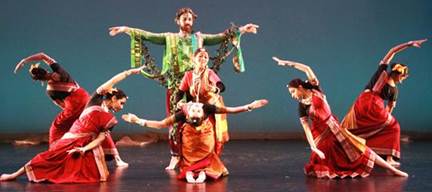 The first half was purely Indian classical dance focusing on the relationship between a mother and child portrayed in multiple ways. In the second item, a parallel was drawn between the relationship between Yashoda and Krishna and a modern-day mother and her son. This dance was the audience’s favorite with Nandini Mandal first portraying both Yashoda and Krishna; then InterPlay’s Sheila Collins danced to show the relationship between herself and her children reciting excerpts from her book Warrior Mother. The recital was riveting, driving home the point that a mother’s love for her child is eternal through all the passage of time.
The first half was purely Indian classical dance focusing on the relationship between a mother and child portrayed in multiple ways. In the second item, a parallel was drawn between the relationship between Yashoda and Krishna and a modern-day mother and her son. This dance was the audience’s favorite with Nandini Mandal first portraying both Yashoda and Krishna; then InterPlay’s Sheila Collins danced to show the relationship between herself and her children reciting excerpts from her book Warrior Mother. The recital was riveting, driving home the point that a mother’s love for her child is eternal through all the passage of time.
The second half was dedicated to Mother Nature, choreographed in the Chau style of Indian dance. The story of a kingdom in which villagers, especially women, fought against their king as he tried to cut down their beloved trees was paralleled with the modern-day Chipko or Tree-hugger Movement that has spread across the world. The combination of Indian and American dance forms for telling this story was well done. InterPlay’s Neil Straub portrayed the tree and Sheila Collins and Shari Mastalski danced to tell the stories of modern-day deforestation around the world.
The imaginatively done last piece was inspiring: A young girl is tending to a sapling she found after all trees had been felled. As she cared for the sapling, slowly other saplings sprouted. The dancers begin as logs, and slowly, one-by-one, they grew into trees, first with their hands, and then with their entire bodies. It was a finale that will be hard to forget.
Overall, Prakriti was enjoyable and educative. The focus on mother-child relations as well as Mother Nature kept the audience engaged, bringing parallels to modern-day life. Integrating beautiful Indian dance (choreographed by Nandini Mandal and Sanjib Bhattacharya) with InterPlay’s unique style was seamlessly done. ï®
Our Experience with Longwood at Home
Posted by admin in January 2015 on January 21, 2015
Balwant N. Dixit, Ph.D.
608 Ravencrest Road, Pittsburgh, PAÂ 15215 USA
(412) 963-8023, e-mail: Â bdixit@pitt.edu
Note: Balwant Dixit is now a professor emeritus in pharmacology at the University of Pittsburgh.
My wife, Vidya, my son Sunil and I flew to Washington DC on June 6th for a short vacation and checked into a hotel in Alexandria (VA), about a mile from a Metro station. On the first day we spent most of our time visiting the Holocaust Museum. We had to wait for two hours to get in, but it was worth the wait. The next day we walked from the Smithsonian Metro stop all the way to the Lincoln Memorial, a distance of over a mile. My wife, Vidya, suddenly came down with intense pain in her left leg; she could not even stand up and nearly collapsed. A park ranger came and tried to help but realized the situation was serious. She called DC EMS and Vidya was taken to the George Washington University Hospital (GWUH) emergency room. Initially admission was declined since Vidya’s insurance plan rejected the emergency room coverage as well as in-hospital stay. I had to sign papers agreeing to pay the bills in case our claim was rejected. I knew that since Vidya was never employed in the USA, she does not have Medicare A & B coverage on her SS#, although her “UPMC for Life†insurance ID card lists her SS#. I suggested to the admitting nurse that she try my SS# since Vidya’s Medicare A & B is on my SS#. It worked. Vidya was admitted for emergency care and given pain control medication. X-ray and a few other tests were necessary for a diagnosis. After about four hours, I was informed that Vidya needed to be admitted for additional care since she was not able to stand up or walk even a few steps. I wanted to stay in DC until a diagnosis was made, but could not find a room to stay after June 8th anywhere in the DC area or in nearby suburbs, except for one room in the Pentagon City for just two days and another room in DC for $550/night. Inter-hotel accommodation services were not helpful either. Hotels recommended by the GWUH were also full. Vidya agreed to stay in the hospital and Sunil and I returned to Pittsburgh on June 9th. Our “UPMC for Life†plan (a Medicare Advantage Plan) covers only the Commonwealth of Pennsylvania. After four days in the hospital Vidya was transported by a fully equipped EMS ambulance with the help of Assist America from Washington DC to Pittsburgh (246 miles). All those who have “UPMC for Life†plans also get Assist America as one of the benefits for no additional payment.
What is Assist America? Assist America, a global emergency travel assistance plan, helps you when you have a medical emergency more than 100 miles from home and are not sure where to turn. I found out that Assist America will not provide services if a patient needs to be transported from one medical facility to another medical facility of similar capabilities, but Assist America will transport a patient from a medical facility to the patient’s residence. Assist America services are accessible 24 hours a day and free of charge to members. A single phone call activates Assist America services 24 hours/day, 365 days/year and is available from any location in the world — no exceptions. Communication specialists are available in any language — from Arabic to Zulu. There are no costs and minimal restrictions. Assist America pays for all the services it provides. There is no financial cap on any of the Assist America services. Not all health insurance carriers provide Assist America as a benefit. More than 300,000 companies and schools do. One should call the host insurance carrier for more information.
When I contacted a representative of Assist America and gave him all the details about the condition my wife was in, he suggested that my wife would be transported by taxi cab with a driver but no other equipment such as a cane, walker, or wheelchair would be available to her, since it takes a minimum of 2.5 hours for a cab to come to Pittsburgh from GWUH. She could either sit in the front seat or could travel “lying down†in the back seat. I suggested that he use MAPQUEST to find out the driving time and the distance.
He was surprised that the distance is 246 miles. When I suggested that my wife’s condition was such that she needed to be transported by ambulance, I was informed that I needed to make some other arrangements. So, as a standby, I contacted a private medical transport company which agreed to provide the necessary transport at a cost of $3,600. I then informed the representative of GWUH dealing with the situation that under the Medicare Act a patient can reject discharge if he/she feels insecure after discharge and from that point on all the hospital charges become the responsibility of the hospital. I advised Vidya not to leave GWUH unless a Medicare representative came to see her. The situation changed very rapidly. The next day at 6:00 AM a representative of Assist America called and informed me that my wife will be transported to Pittsburgh by a fully equipped EMS ambulance. It took almost 6.5 hours for the EMS ambulance to reach our home in Pittsburgh from GWUH. After her return to Pittsburgh Vidya underwent X-ray, MRI and bone scans and is being treated by two orthopedic physicians. Although no definitive diagnosis has been made, with physical therapy and other supportive treatment she has shown considerable progress.
What happened to Vidya can happen to anyone anywhere. One must be prepared with all the information to deal with such situations. I learned a lot. All throughout this time our assigned social worker from Longwood at Home was working with us to get everything arranged. When the ambulance arrived at our house, the Director of Home Care, a care giver and our social worker were there in the drive-way to help. For the next 48 hours care was provided around the clock and from then on, care givers have been visiting us every day for 8 to 10 hours providing help as needed. All caregivers come on time and are well behaved and trained, and as of today (July 30th), over 250 hours of assistance has been given. Caregivers also helped in many household chores such as meal preparations (if asked), grocery shopping, prescription pick-up, taking Vidya to medical tests and to doctor’s appointments. They did regular laundry, cleaning dishes and vacuuming as well as garbage disposal and any other light housekeeping chores we asked for. Each caregiver wrote a brief report on Vidya’s progress, medications she took, her diet as well as all other activities she participated in. Such logs were helpful for the subsequent caregivers and also to the supervisor who monitors the services provided. Becoming a member of Longwood at Home was the most rational decision we made two years ago. We did not have to file any claims, had no waiting time to qualify to receive help, and made no payment for any services we have received. In my opinion LaH is a much better option than having Long Term Care Insurance. We learned a lot from this unusual experience.  Unexpected adversity provides a great learning experience, but it has its own cost! In another issue I will describe in details Continuing Care at Home (CCAH) programs.
Acknowledgement: Grace Smith of LaH, Sudhir Manohar and Girish Godbole made useful comments. ♦ ï®
University of Pittsburgh’s New Lecture Series on South Asia Focused on India
Posted by admin in January 2015 on January 21, 2015
By Premlata Venkataraman
e-mail: Â ThePatrika@aol.com
Mobasher Jawed Akbar, popularly known as MJ Akbar, the official spokesperson for the Bharatiya Janata party (BJP) spoke on September 30 at the University of Pittsburgh on “India After the 2014 Elections.†His talk focused on the “new leadership, priorities and possibilities.â€
For the geopolitical and business interests of the US, India is strategically important. So, the University of Pittsburgh started this year an annual lecture series at its South Asian Studies department. India is front and center of South Asia not only in geography (see the 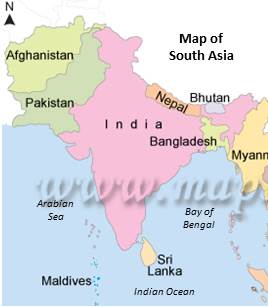 map), but also in culture, history, and economy. Akbar was the first speaker in this series.
map), but also in culture, history, and economy. Akbar was the first speaker in this series.
Akbar’s is a well-known name in India and in the Indian subcontinent. His name as a journalist is associated with a long list of well-known publications. He also was a Congress Party MP and served as the official spokesperson for Rajiv Gandhi when he was India’s prime minister. Currently Akbar is the spokesperson for the BJP, which he joined just two months before the 2014 elections — talk about good timing. How many political operatives in the world’s large democracies have been so close to two diametrically opposed political systems?
Akbar was introduced to the audience of over 200 people by Mark Nordenberg, who recently ended his long tenure as the university’s chancellor. Nordenberg, as he told his audience, is related to Akbar as sambhandhi,with his son marrying Akbar’s daughter.
Akbar started by stating that India’s impatient youth — 54% of the population is under 25 years of age — had reached a point where the lethargic status-quo was no longer acceptable, which was the main reason for BJP’s spectacular victory, with Modi becoming India’s Prime Minister. He highlighted the changes the BJP has made by focusing on four decisions.
• Abandoning the Planning Commission, a relic of the Soviet model of planning adopted by Jawaharlal Nehru and the Congress Party. The post-colonial reality of India was that 60% of people lived below the poverty line. Even 60 years after India’s independence poverty was reduced only by half. The BJP believes in poverty elimination not alleviation.
Government wants the private sector to create millions of new jobs. Government wants to do this while protecting the environment and the poor. BJP looks beyond the ideology from both the Left and the Right, and will pursue ideas that work.
• Secondly, Modi recognizes that “Trickle Down economics,†a term popularized by Ronald Reagan in the 1980s, does not work. Even the poorest need to be an integral part of India’s economy, and that is why it brings these people into India’s formal banking sector. Empowering people at the bottom gives them much needed purchasing power wjhgich benefits India’s manufacturing and service sectors.
• Third, Modi’s background gives him a better understanding of the difficulties of those stuck in the cycle of poverty. He addressed the need for toilets for every Indian from the Red Fort in his Independence Day speech. He took part in the Global Citizen’s concert at Central Park, joining in efforts to provide access to toilet for all in India. This initiative will give basic dignity to women in rural India, so that girls feel safe going to school (but only when fulfilled, we must say).
• Fourth, Akbar emphasized that the secularism of India predates by many centuries the secularism of Europ., India accepts all faiths and belief systems. It is in the very fiber of every Indian. Gandhiji is the best symbol of secularism in India, gaining inspiration from the Hindu, Christian and Muslim faiths. Modi, he said, wants the Muslims to be strong in their faith but modern in outlook and participate in India’s growth. Indian Muslims are as patriotic as anybody else in India.
Modi’s vision, Akbar said, is looking towards the East. Symbolically, Modi came to the United States after visiting Japan and after Chinese President Xi’s state visit to India. In Akbar’s choice of words, “East of India is growth, prosperity and productivity, and west of India is a wasteland all the way up to Morocco on the west coast of Northern Africa.â€Â Only three countries, India, Iran and Israel, he said, have stable governments and democracy. The Middle East, he said, is slipping into medievalism.
On the question of Pakistan, Akbar was quite blunt. Alluding to the rise of Syria’s Islamic State, IS, Akbar said, “Pakistan is the first Islamic State,†and hence a natural home for Osama Bin Laden. While the US has sought Pakistan as a solution to their terrorism problems, Akbar said, India sees Pakistan as a problem.   ♦
Beware of Charlatans in Your Spiritual Journey
Posted by admin in January 2015 on January 21, 2015
By Kollengode SÂ Venkataraman
e-mail: Â ThePatrika@aol.com
Taayumaanavar, a great poet-spiritualist-philosopher (1705-1742), lived in Tamil Nadu, expounding Advaita Saiva Siddhantam. His Tamil name splits into Taayum and aanavar, meaning in Tamil He Who is Also the Mother, a descriptive reference to Shiva. In Sanskrit, it would be Maatr-bhooteshwara.
He was born not in a brahmin family but in a Vellala family deeply steeped in Saivism. His parents were Kediliappa Pillai and Gajavalli Amma. Though most of his poems are addressed to Saiva deities, he was a universalist on matters of spirituality. In many verses he addresses the Infinite using a Tamil word PoruL, literally meaning “The Thing.†Most probably, he would have struggled for a long time and failed to find a word or phrase to comprehensively and precisely define the Infinite. So, he chose poruL, the same way the Upanishads use tat, literally meaning That.
Etymologically speaking, the English that is cognate with, and derived from, the Sanskrit tat. Can you get any closer either phonetically or in spelling?
In an alliterating Tamil verse Taayumaanavar says how difficult it is to master one’s own mind, a prerequisite in our spiritual journey:
You can control an elephant, catch hold of a tiger’s tail,
Grab the snake and dance, dictate to angels,
Transmigrate into another body, walk on water or sit on the ocean;
But it is far more difficult to still your mind and remain quiet.
He was impatient with theological hair-splitting, common in his time, as it is in ours. After serving as a minister for the Maratha king Vijayaranga Chokkanatha Nayak of Tanjavoor, he quit and became a mendicant.
Taayumaanava Swamy was a scholar in both Tamil and Sanskrit. If you want to understand and enjoy his several hundred verses composed in a variety of complex Tamil meters, grounding in Sanskrit and the Indian metaphysical ideas are necessary. Well-versed in the two classical languages, he would have easily identified charlatans of his time as we see in the following non-poetic translation of his verse in a dasakam (padigam in Tamil), a set of ten verses on a theme, called Siddhar Ganam:
Coming to think of it, the illiterate are indeed virtuous.
Look at my karma and my intelligence [that’s impetuous].
I’m well-read, but still live in ignorance!
If a wise person advises, “The liberating Jnana (wisdom) is worthy of pursuit,â€
Karma (action) is more important, I will assert.
But if one defends Karma as the better option,
I’ll argue, “The good old Jnana is more important.â€
With a Sanskrit pandit, I will elaborate on how great Tamil is.
When meeting people well-versed in Tamil,
I will dazzle them with a few Sanskrit shlokas.
My conceited bombast frustrates everyone, but convinces none!
O, the skilled Siddhas, You’ve reconciled the ideas of Vedanta and Siddhanta!
Will this talent of mine ever give me Mukti (liberation)?
The answer to his rhetorical question is obvious: No. Taayumaanavar deftly brings out the hypocrisy in us by employing the first person singular in the verse. Obviously, he is not referring to himself. But when you read his verse, you may see shades of yourself in the first person pronouns I, my, mine, and first-person case-endings in the verbs. This technique is commonly used by Bhakti poets all over India since the 5th century to temper our vanity and pride.
Today we see modern versions of Taayumaanavar’s archetype all over India. You have to only replace Sanskrit with English, French, German, Arabic, Persian, or any Indian language other than your native tongue.
Here is the Tamil original for you to enjoy the alliterative and rhyming verse of this great poet-philosopher:
♦
The High-Stakes Poker Game in World Trade
Posted by admin in October 2014 on October 2, 2014
  By Kollengode S Venkataraman
e-mail: Â ThePatrika@aol.com
In July India’s newly elected Modi government blocked what is known in the arcane world of global trade as the Trade Facilitation Agreement (TFA). Key elements of the TFA are reducing import tariffs, bureaucratic delays and subsidies to farming in member countries.
The details of the World Trade Organization’s TFA were agreed to in the ministerial meeting in Bali in December 2013 with India participating under Manmohan Singh’s government. Though India agreed to the TFA, it also wanted the WTO to simultaneously address India’s need for food subsidies. These subsidies are lifelines for the millions and millions of subsistence farmers worldwide. Another issue is the stockpiling of food grains as an insurance against famines/droughts. Signing this by the 160-strong WTO countries (out of 180-plus UN members) was thought to be a formality. However, the WTO did not address these issues. So India under Modi’s government, blocked the ratification of TFA. Several non-G-8 members except China, Brazil, Pakistan, and Thailand supported India.
The stockpiling of food grains is important to India given the unpredictable monsoons and the on-again-off-again droughts. Granted, India’s cantankerous and corrupt state governments need to better manage their water resources and improve the productivity in farming, but this will take time. With the chronic threat of droughts, if not famines, the problem for India is here and now.
But protection from cheaper imports always gives complacency for the local industries. India’s economic stagnation before 1990 itself is an example of this. That is India’s dilemma.
For the uninformed, India, along with the other BRICS nations and the ASEAN nations, among others, are now called Newly Industrialized Countries. The bottom in this classification is LCDs or the Least Developed Countries, mostly in Sub-Saharan Africa, and Nepal, Afghanistan, Bhutan, Myanmar… Recognizing the unique problems of LCDs, the WTO affirmed that all nations will provide duty- and quota-free market access for goods from LCDs.
That India wants to stock-pile food as insurance against famine would be understandable if only one cares to know how India has been ravaged by famines. Here are the big ones in a long list:
♠  The Bengal Famine of 1770 during the Mughal Empire-East India Company transition. Ten million people died. Bengal’s population was reduced by 33%. Neglect by the rulers was a main cause.
♠  The Great Famine of 1876–78 in South India under the British Occupation. 5.5 million people died. With South India’s population 50 to 60 million then, 10% of the people, mostly the poor, died.
♠  Bengal’s man-made famine in 1943 during WW II under the British rule. Two million deaths. Bengal’s population was 60 million.
â™ Â Â Bangladesh famine of 1974. One million died.
With the democratically elected governments in India, large-scale famine-related deaths today would end in a bloody revolution.
In the early 1960s many parts of India were in severe drought. With Jawaharlal Nehru’s Congress government mismanaging the farming sector’s multi-faceted needs, India went begging for food all over the world at a time when nearly 60% of Indians were engaged in farming. India has not forgotten the embarrassment and shame.
South and Southeast Asia depend on monsoon rains for farming. Every April/May, Indian meteorologists closely follow the weather pattern in the Philippines region to predict the arrival and scale of the monsoon in India and warn the governments on shortfalls in rain and potentials for droughts. If the monsoon is delayed or is weak, it is front page news today even in India’s tech-savvy business publications. India’s arid regions — the Dakshin (Deccan) Plateau, the states of Bihar, Odisha, even many river deltas — go through droughts when the monsoon falters.
In recent years, many farmers in Andhra Pradesh, Maharashtra and other places got into heavy debt to pay for the costly genetically modified seeds they need to buy from big overseas companies for every planting season. Many killed themselves because there was no way to get out of their debt from their low-profit-margin harvests.
In India today 40% of the population lives in rural and semi urban areas; 25% of the population or 300 million — equivalent to the entire population of the US — is engaged in farming. So, Indian elected officials have every reason to safeguard their farming sector for their national and social interests — and for their political survival. For India, food security is its national security. Even military comes only next.
Besides, Indian farmers already depend on big corporations for a whole range of supplies: fertilizers weed killers and pesticides, pumps, farm equipment, and diesel… … and on government for electricity and water irrigated through canals.
So, in Australia, before the July 31 deadline for the TFA signing, India held its ground: “The way things are moving, there is no way [India] can agree to the trade facilitation agreement being pushed by the developed nations… Food security has always been India’s main concern and this time we are not going to concede,†and “[It] will be really difficult for India to sign the TFA till WTO [is] ready to discuss a permanent solution of food subsidies and stockpiling of food grains.â€
Remember, in the industrialized economies, only 2 to 3% of the population is directly engaged in farming, which is an incredibly energy- and resource-intensive and fully mechanized enterprise. In the US, corporate farming has all but eliminated family-owned farmers. And the farming industry, owned by large corporations, is still subsidized with billions and billions of dollars. The US taxpayers spend $14 billion every year insuring farmers against loss of crop or income. And often, farmers are paid for every acre of the land they leave fallow.
Often, with such subsidies, the G-8 (and other countries as well) dump their farm products at prices below their production costs to Africa and other poorer nations, where farming is pursued by many just to survive.
With great irony and sarcasm, Joseph Stiglitz in NYT Nov 16, 2013 summarized the situation thus: “We [the US government] spend billions every year on farm subsidies, many of which help wealthy commercial operations to plant more crops than we need. The glut depresses world crop prices, harming farmers in developing countries.â€
Further, in the US, over 40 million people living below the official poverty line receive tax-payer funded Food Stamps (called Supplemental Nutrition Assistance Program). This is valued at $70 billion/year, or $1750 per recipient. It is noble that the government is taking care of the poor through these programs. After all, we are the richest, technically and militarily the most powerful country on earth.
People on Food Stamps can use them only to buy staples — breads, cheese, meat, vegetables, cereals, milk, eggs, etc. So, the indirect beneficiaries of the Food Stamps are the big agribusinesses who are assured of $70 billion business per year. This is a form of farm subsidy. Similar subsidies for agribusinesses are entrenched in all modern nation-states.
In addition, the TFA agreement limits the value of food subsidies to 10% of the total value of food grain production. India is flexing its muscle on this issue because the subsidies will be calculated taking 1986 as the base year. In India, where inflation is running at 6 to 7% a year, 1986 as the baseline is meaningless, even laughable.
The TFA, it is believed, would add over $1 trillion to the GDPs worldwide creating 21 million jobs. But the operative word in WTO is Trade, not farming. As every farmer in India knows, the beneficiaries in any market situation — glut or scarcity — are the wholesale and retail traders. The subsistence farmers only see small slivers of profits in good times, but are hit hard during droughts.
In the Chicago Mercantile Exchange, the largest trading place for agribusiness where all farm products are traded — grains, beans, poultry, beef, eggs, milk, cheese, even alfalfa-hay — billions are made and lost every day speculating on everything affecting any aspects of farming. So, if the TFA is ratified, subsistence farmers worldwide would need to deal with speculative traders on a global scale.
The rich and powerful members of the WTO worry that they would lose control in global trade in agribusiness if the TFA is not ratified. But poorer nations see the TFA as an effort by developed countries to access vast markets in their growing economies. Because of this irreconcilable built-in conflict, each group negotiates for its advantage. There is no altruism here. US Ambassador Michael Punke warned the WTO in Geneva, “Today, we are extremely discouraged that a small handful of members… … are ready to walk away from their commitments… … Bali agreement, to kill the power of that good faith and goodwill we all shared, to flip the lights in this building back to dark.â€
Geopolitically speaking, the G-8 members have been at this game for years and years dictating to other nations on monetary, economic, military, and political issues. When they are on the receiving end, it hurts them.
What is worrying them is that emerging bilateral and regional free trade agreements will weaken the reach of the WTO. But these regional/bilateral trade arrangements make sense given the regional nature of rainfall, weather patterns, biodiversity, ecology, transportation, population density, culture, lifestyles and even food habits. So, putting a brake on the WTO’s ambitious FTA may not be all that bad—it may even be a good thing.
This time, the Big Boys at the WTO are dismayed that India is not blinking in the high-stakes poker game. Even though they threatened to go ahead with the TFA with or without India, they cannot simply ignore India geopolitically. India houses 1/6th of the world population; has been a stable democracy with a disciplined military that has no ambition for political power; has a large technical talents pool; and offers a countervailing force, partially in any case, for China’s ambition as a global power. India also offers limitless opportunities for foreign direct investments in many sectors, whose beneficiaries are businesses in the G-8 countries. That is their dilemma.   ï®
India Day 2014 Celebrated With the Usual Gusto
Posted by admin in October 2014 on October 2, 2014
By David Downey     e-mail: davidpdowney6@gmail.com
Note: David Downey, a recent graduate from the Dietrich School of Arts and Sciences at the University of Pittsburgh, seeks work in academic or scholarship administration.
Late summer once again brought the India Day celebration to the Cathedral of Learning at the University of Pittsburgh. On Sunday, August 17, the Indian diaspora and curious passersby gathered to celebrate 67 years of Indian independence. The theme of this year’s event was Punjab and its leaders who fought for their political and religious freedom and also for others’ freedom on matters of faith.
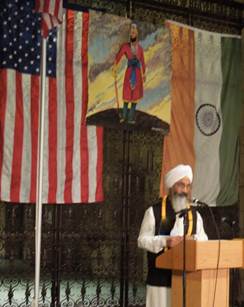
Gyani Sucha Singh of the Gurudwara in Monroeville addressing the gathering in the function. The imposing portrait of Guru Gobind Singh in the backdrop is by Mahendra Shah.
The overcast sky withheld its rain. And the sun didn’t need to be shining as the parade around the Cathedral lit up the gloomy afternoon with joyous song and dance with Keerti Gulati and Sumedha Nagpal as emcees. At the conclusion of the parade, everyone crowded inside to absorb the ambience with performances, speeches, and the aroma of food. Past the hoisting of both the Indian and American flags and singing their national anthems, Kalpana Ramgopal and Parth Bharill emceed the program.
The speeches were heartfelt and sincere and brief for the most part. First was Patrick Gallagher, the new chancellor of the University of Pittsburgh. Having been at the job for only two weeks, the India Day was one of the first events for Chancellor Gallagher to represent the University.
County Chief Executive Rich Fitzgerald also spoke briefly, thanking the Indian community of Pittsburgh for its ongoing contribution to the region’s vitality, officially proclaiming August 17th to be India Day in Allegheny County. He said Indian-Americans “have been absolutely instrumental in the moving forward of what Pittsburgh has become… not just economically, but culturally and in quality of life.â€
Gyani Sucha Singh, the Granthi — the trained Sikh teacher who explains the Adi Granth to his audience — at the Sikh Gurudwara, elegantly and passionately told his audience the impact of the Sikhs’ 10th Guru, Guru Gobind Singh of the 17th century, in the history of Punjab.
Mayor Bill Peduto, a well-known face in India Day events, was not scheduled to be present because of scheduling conflicts. However, he made a brief appearance addressing the young girls and women in the audience, saying they should get inspiration from the life of Pittsburgh’s first woman Mayor Sophie Masloff, who had passed away the previous night.
Later, Ashok Trivedi, Co-Founder of iGATE, spoke at length about India’s political and economic struggles & successes. Trivedi both challenged and addressed the difficult issues in a global economy.
The term culture can denote many elements of life, but India Day celebrated culture in every way. The performing arts were the most exciting events inside the Cathedral. Dances by the students of Jaya Mani, Shambhavi Desai, and Nandini Mandal involved skill to maintain rhythm and control the movement of every limb, which are impressive all by themslves, but the groups’ synchronization made the performances astounding.
Culture was visually apparent in the color, design, and styles of dresses worn by the festivalgoers. The unlimited variations stood as a reminder to the durable creativity of those who craft Indian clothing. There was not one style or one color more common than another. Traditional dresses could be found on men and women, young and old, showing the timeless appeal and joy brought by the distinctly Indian attire.
Songs rendered in group and solo in Hindi and Tamil nicely complemented the dances.
Food is always a distinguishing feature of the Indian culture. The food stand managed by All India Authentic Cuisine with the usual items operated without a lull. The appeal of Indian food is becoming widely recognized, considering the success of the recent American film The One-Hundred Foot Journey, aboyt an Indian family opening a restaurant in France.
And there were booths around the outer edges of the festival area on many activities — The Art of Living, Overseas Volunteer for a Better India, South Asian Marrow Association of Recruiters (SAMAR), Association for India’s Development (AID), Pittsburgh Indian Community & Friends 5K Charity Walk/Run + Fun, Ekal Vidyalaya, Ramakrishna Ashrama Pittsburgh, Pittsburgh Sikh Gurdwara, and Pittsburgh Tamil Sangam. There were booths on saris, lehngas, kurtas… … even mehndi designs.
The finale was a bhangra item by Monica Srinivasa and the Tri-State-Sikh Cultural Society, a high-level-competing troupe. The high-decibel bhangra was a perfect end to the evening, whose theme was Punjab. Â Â ï®
How to Collect Taxes — A Vignette from the Indian Literature
Posted by admin in October 2014 on October 2, 2014
Kollengode S. Venkataraman
e-mail: Â ThePatrika@aol.com
Corruption and bureaucratic excesses have been the bane of all kingdoms. This has been the case ever since mankind organized itself into societies seeking help from local leaders by paying them protection money against thieves and thugs to guard their homes, women, lands and harvests from pillage. That is the beginning of taxes.
Soon, much to their dismay, the villagers saw that the servants of the kings themselves becoming the exploiters. Sometimes they were as bad as the thugs from whom the villagers were seeking protection. Such was the case in the ancient Tamil country, nearly 2000 years ago. Many people say, it is the same story even today not only in the Tamil Country, but also in much of India.
Enter Pisirandaiyaar, a courageous and socially conscious poet in such a scene. The poet confronts his Pandya King, Arivudai-nambi, subtly telling him of the excesses of his tax collectors towards his citizens. Here is the Tamil original in classic Tamil from Puranaanooru, dated earlier to the start of the Common Era (that is, 2000 years earlier to our time):
This Tamil is very different even from today’s formal Tamil, not to speak of the spoken masala Tamil on the streets. Pisirandaiyaar uses an excellent agrarian imagery to tell his king on his citizens suffering under his tax collectors’ excesses. Here is the sum and substance of the Tamil verse: 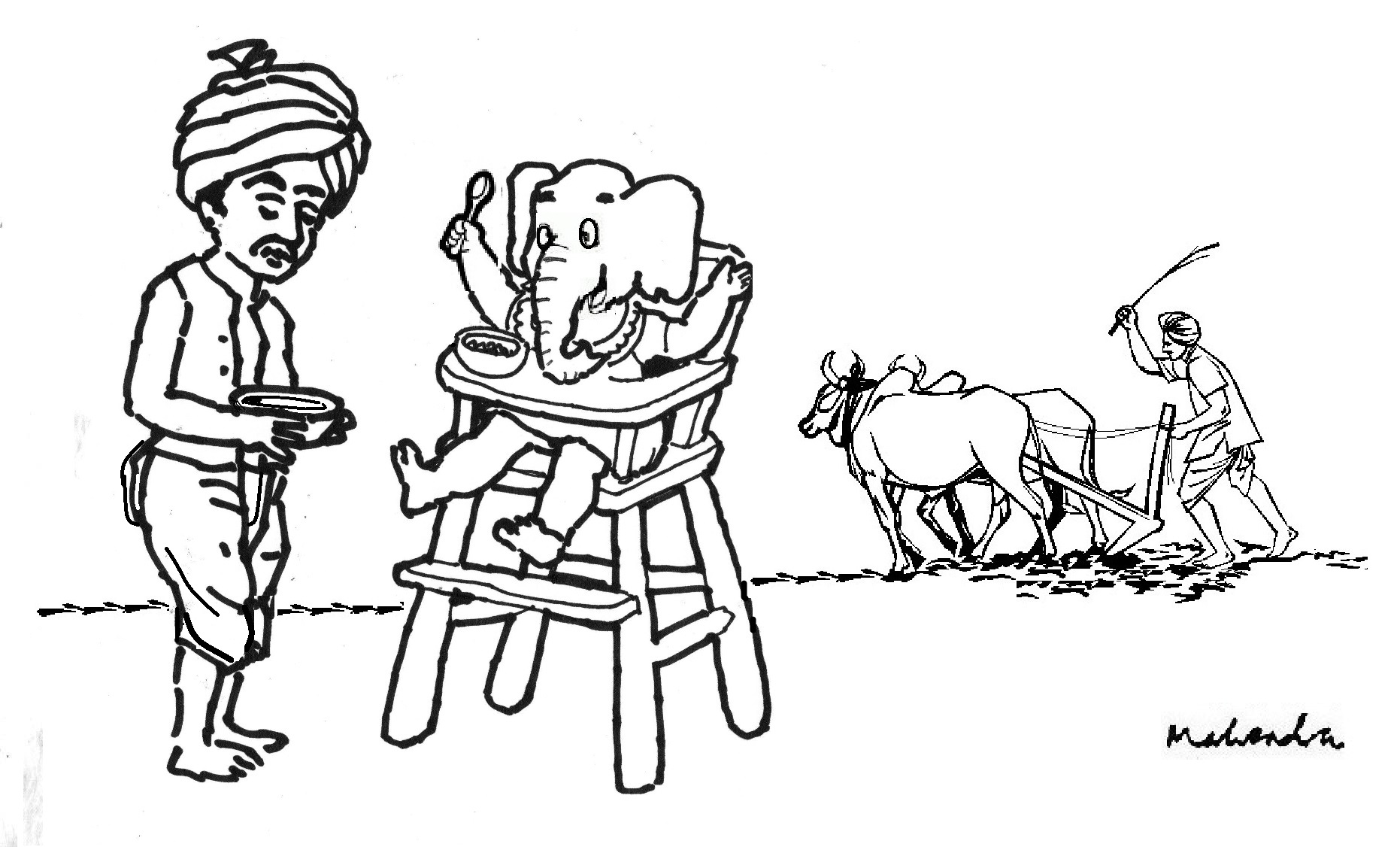
“If one harvests rice and feeds an elephant with the rice cooked and made into large balls, even from a small field [a fraction of an acre], one can feed the elephant for very many days.
“However, if one lets the elephant get into the paddy field and eat, even several acres of land cannot feed the beast. For every morsel of rice the elephant puts into its mouth, several ten folds are destroyed by its massive legs stomping on the harvest.
“Knowing this, a wise king is careful while collecting taxes from citizens. Then, even with low taxes, his kingdom prospers.
“However, if the king is weak, listens to his bad advisers, and recklessly lets his underlings to extract high taxes from citizens under duress, his kingdom would be destroyed the same way the elephant destroys the paddy field when allowed to enter it to feed for itself.”
Note that Pisirandaiyaar, over 2000 years ago, compared the bureaucracy of his time to an elephant, an imagery used even today even  in countries like the US and Germany, and France where elephants are not native to the soil.   ï®

